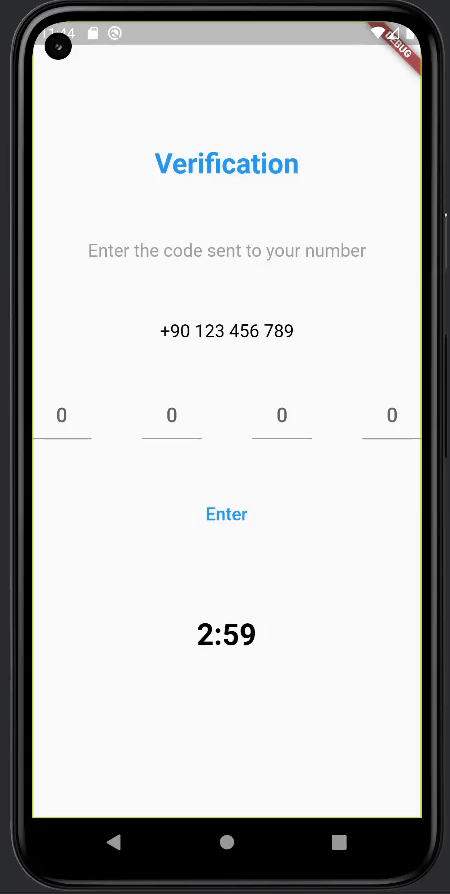Flutter短信验证码插件sms_otp的使用
Flutter短信验证码插件sms_otp的使用
sms_otp 插件包含多个有用的容器,可以帮助你构建应用中的短信或验证码输入界面。该插件包含了用于显示标题、描述文本、电话号码和验证码输入框的容器。
特性

开始使用
首先,你需要在 pubspec.yaml 文件中添加 sms_otp 依赖项:
dependencies:
sms_otp: ^版本号
然后,你可以创建一个简单的示例来展示如何使用 SmsOtp 组件:
import 'package:flutter/material.dart';
import 'package:sms_otp/sms_otp.dart';
void main() => runApp(MyApp());
class MyApp extends StatelessWidget {
[@override](/user/override)
Widget build(BuildContext context) {
return MaterialApp(
home: Scaffold(
appBar: AppBar(
title: Text('短信验证码示例'),
),
body: Center(
child: SmsOtpExample(),
),
),
);
}
}
class SmsOtpExample extends StatelessWidget {
const SmsOtpExample({Key? key}) : super(key: key);
[@override](/user/override)
Widget build(BuildContext context) {
// 定义按钮点击事件函数
void btnOnPressedFunction() {
print("按钮被点击了!");
}
// 定义倒计时结束事件函数
void durationTimeOnEndFunction() {
print("倒计时结束!");
}
return Scaffold(
body: Center(
child: SmsOtp(
title: "验证", // 设置标题
textMargin: 40, // 设置描述文本的边距
text: "请输入发送到您手机上的验证码", // 设置描述文本
phoneNumberMargin: 40, // 设置电话号码的边距
phoneNumber: "+90 123 456 789", // 设置电话号码
pinHeight: 68.0, // 设置每个验证码框的高度
pinWidth: 64.0, // 设置每个验证码框的宽度
btnMargin: 40, // 设置按钮的边距
btnOnPressed: () => btnOnPressedFunction, // 设置按钮点击事件
btnText: "确认", // 设置按钮文本
durationTimeMargin: 40, // 设置倒计时文本的边距
durationTime: 3, // 设置倒计时时间(秒)
durationTimeOnEnd: () => durationTimeOnEndFunction, // 设置倒计时结束事件
),
),
);
}
}
更多关于Flutter短信验证码插件sms_otp的使用的实战系列教程也可以访问 https://www.itying.com/category-92-b0.html
更多关于Flutter短信验证码插件sms_otp的使用的实战系列教程也可以访问 https://www.itying.com/category-92-b0.html
当然,以下是一个关于如何在Flutter项目中使用sms_otp插件来处理短信验证码的示例代码。这个插件通常用于实现短信验证码的自动读取和验证功能。
首先,确保你已经在pubspec.yaml文件中添加了sms_otp依赖:
dependencies:
flutter:
sdk: flutter
sms_otp: ^x.y.z # 请替换为最新版本号
然后运行flutter pub get来安装依赖。
接下来,在你的Flutter项目中,你可以按照以下步骤使用sms_otp插件:
- 初始化插件:
在你的主文件(通常是main.dart)或者你需要使用短信验证码功能的页面中,导入sms_otp包并初始化它。
import 'package:flutter/material.dart';
import 'package:sms_otp/sms_otp.dart';
void main() {
runApp(MyApp());
}
class MyApp extends StatefulWidget {
@override
_MyAppState createState() => _MyAppState();
}
class _MyAppState extends State<MyApp> {
SmsOtp? _smsOtp;
@override
void initState() {
super.initState();
_initSmsOtp();
}
Future<void> _initSmsOtp() async {
_smsOtp = SmsOtp();
_smsOtp!.startListeningForMessages();
// 监听短信到达事件
_smsOtp!.messageStream!.listen((SmsMessage message) {
// 在这里处理接收到的短信
print("Received message: ${message.body}");
// 假设验证码是6位数字
RegExp exp = RegExp(r'\d{6}');
Iterable<Match> matches = exp.allMatches(message.body);
if (matches.isNotEmpty) {
String otp = matches.first.group(0)!;
print("OTP found: $otp");
// TODO: 使用OTP进行验证
}
});
}
@override
Widget build(BuildContext context) {
return MaterialApp(
home: Scaffold(
appBar: AppBar(
title: Text('SMS OTP Example'),
),
body: Center(
child: Text('Waiting for OTP...'),
),
),
);
}
@override
void dispose() {
_smsOtp?.stopListeningForMessages();
super.dispose();
}
}
- 发送验证码请求:
通常,你会在用户点击某个按钮后发送验证码请求到你的服务器。这里假设你已经有一个发送验证码的API,下面是一个简单的按钮点击事件示例:
// 假设你有一个发送验证码的函数
Future<void> _sendOtpRequest() async {
// 这里调用你的API发送验证码请求
// 例如:await sendOtpToPhoneNumber('用户的手机号');
print("OTP sent to user's phone number");
}
// 在你的Scaffold的body中添加一个按钮来发送验证码
body: Center(
child: Column(
mainAxisAlignment: MainAxisAlignment.center,
children: <Widget>[
ElevatedButton(
onPressed: _sendOtpRequest,
child: Text('Send OTP'),
),
Text('Waiting for OTP...'),
],
),
),
- 验证验证码:
用户收到验证码后,可能会手动输入验证码进行验证,或者你已经从短信中自动提取了验证码。以下是一个简单的验证示例:
// 假设你有一个验证验证码的函数
Future<void> _verifyOtp(String inputOtp) async {
// 这里调用你的API进行验证码验证
// 例如:bool isVerified = await verifyOtp(inputOtp, '用户的手机号');
bool isVerified = true; // 这里只是模拟
if (isVerified) {
ScaffoldMessenger.of(context).showSnackBar(
SnackBar(content: Text('OTP Verified Successfully')),
);
} else {
ScaffoldMessenger.of(context).showSnackBar(
SnackBar(content: Text('Invalid OTP')),
);
}
}
// 在你的Scaffold的body中添加一个TextField和一个按钮来验证验证码
body: Center(
child: Column(
mainAxisAlignment: MainAxisAlignment.center,
children: <Widget>[
ElevatedButton(
onPressed: _sendOtpRequest,
child: Text('Send OTP'),
),
SizedBox(height: 20),
TextField(
decoration: InputDecoration(labelText: 'Enter OTP'),
onChanged: (value) {
// 你可以在这里实时验证输入,但这里仅作示例
},
),
SizedBox(height: 20),
ElevatedButton(
onPressed: () {
final otpController = TextEditingController.fromValue(
TextEditingValue(text: _otpController.text),
);
_verifyOtp(otpController.text);
},
child: Text('Verify OTP'),
),
],
),
),
注意:在实际应用中,你需要管理TextEditingController来处理TextField的输入,并且在验证码发送和验证过程中处理各种可能的错误情况。
以上代码提供了一个基本的框架,展示了如何在Flutter项目中使用sms_otp插件来处理短信验证码。根据你的具体需求,你可能需要调整和扩展这些代码。








